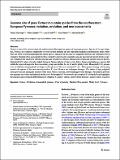Por favor, use este identificador para citar o enlazar a este item:
http://hdl.handle.net/10261/334382COMPARTIR / EXPORTAR:
 SHARE SHARE
 CORE
BASE CORE
BASE
|
|
| Visualizar otros formatos: MARC | Dublin Core | RDF | ORE | MODS | METS | DIDL | DATACITE | |

| Título: | Genome size of grass Festuca mountain species from the southwestern European Pyrenees: variation, evolution, and new assessments |
Autor: | Garnatje, Teresa CSIC ORCID ; Catalán, Pilar; Inda, Luis A.; Vallès, Joan CSIC ORCID; Pyke, Samuel CSIC ORCID | Palabras clave: | Festuca Evolution of monoploid genomes Flow cytometry Nuclear DNA amount Ploidy level Pyrenees |
Fecha de publicación: | 30-jul-2023 | Editor: | Springer Nature | Citación: | Plant Systematics and Evolution 309:29(2023) | Resumen: | Festuca is one of the most ecologically and economically important genera of temperate grasses. Species of its type subgenus, Festuca, are common components of cool-seasonal pastures and are especially frequent in mountainous areas, where there are often several morphologically similar species that grow in the same or comparable habitats and sometimes live in sympatry. Nuclear DNA assessments by flow cytometry can be used to identify taxa and uncover new ploidy levels in species complexes for which new chromosome data are provided or previous chromosome counts and genome sizes are known. Holoploid (2C) values of newly studied Pyrenean Festuca subgen. Festuca sects. Eskia, Festuca and Aulaxyper species fall within the expected ranges for these taxonomic groups and include 2x, 4x, 6x and 8x ploidy levels. Monoploid (1Cx) genome sizes of diploids and polyploids are larger in the species of the more ancestral F. sect. Eskia group showing a decreasing trend in the species of the more recently evolved F. sects. Festuca and Aulaxyper lineages. 1Cx values of high polyploid Aulaxyper taxa are among the smallest of the three Festuca sections, corroborating previous findings. Our analysis provides new genome size values and inferred ploidy levels for hexaploid F. heteromalla and octoploid F. trichophylla and highlights the genomic and ecological differentiation of tetraploid F. gautieri susbsp. gautieri from diploid F. gautieri subsp. scoparia. | Versión del editor: | https://doi.org/10.1007/s00606-023-01867-x | URI: | http://hdl.handle.net/10261/334382 | DOI: | https://doi.org/10.1007/s00606-023-01867-x | Identificadores: | doi: https://doi.org/10.1007/s00606-023-01867-x issn: 0378-2697 e-issn: 1615-6110 |
| Aparece en las colecciones: | (IBB) Artículos |
Ficheros en este ítem:
| Fichero | Descripción | Tamaño | Formato | |
|---|---|---|---|---|
| s00606-023-01867-x.pdf | 713,43 kB | Adobe PDF |  Visualizar/Abrir |
CORE Recommender
Page view(s)
13
checked on 03-may-2024
Download(s)
7
checked on 03-may-2024
Google ScholarTM
Check
Altmetric
Altmetric
Este item está licenciado bajo una Licencia Creative Commons

